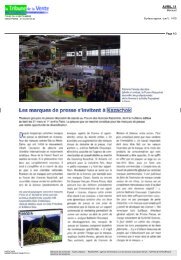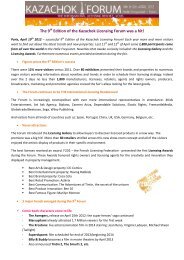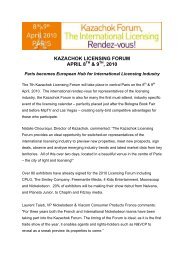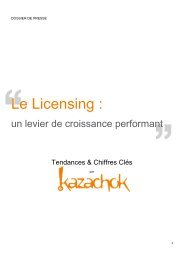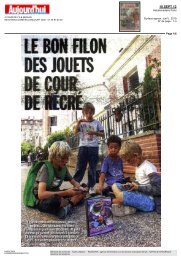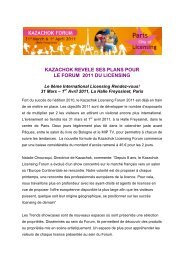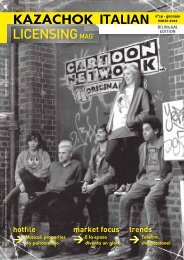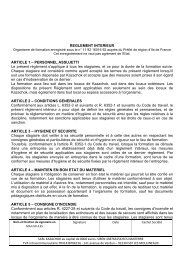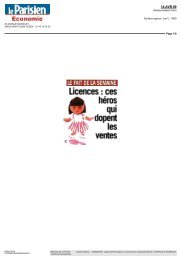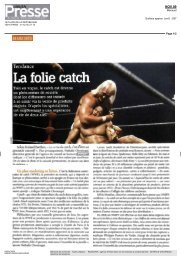You also want an ePaper? Increase the reach of your titles
YUMPU automatically turns print PDFs into web optimized ePapers that Google loves.
legal<br />
di fallace indicazione d’origine<br />
realizzati mediante l’uso del<br />
marchio. Si tratta dei casi in cui il<br />
marchio è utilizzato con modalità tali<br />
da spingere il consumatore ad attribuire<br />
alla merce un’immeritata<br />
origine italiana. In tali casi il produttore<br />
o il licenziatario, per non essere<br />
sanzionati, dovranno indicare chiaramente<br />
l’origine estera dei prodotti.<br />
L’ambiguità di tale disposizione ha<br />
spinto il Ministero dello Sviluppo<br />
Economico ad emanare una circolare<br />
(la n. 124898 del 9 novembre 2009)<br />
che, in un’ottica di maggiore flessibilità,<br />
ha ammesso che al posto del<br />
“Made in China” (per merci ad<br />
esempio prodotte in Cina) sono adottabili<br />
indicazioni alternative quali:<br />
“prodotto fabbricato/ importato/di<br />
provenienza da Paesi Extra UE”, o<br />
semplicemente “prodotto non<br />
fabbricato in Italia”, pure apponibili<br />
su un “cartellino o targhetta”.<br />
Rimane tuttavia ancora non chiaro se<br />
ai fini dell’applicazione di tale norma<br />
L’Avvocato Paolo Lazzarino<br />
66 <strong>Kazachok</strong> Licensing Mag' gennaio - marzo 10<br />
e della relativa sanzione è sufficiente<br />
che il marchio semplicemente<br />
“suoni” italiano o se invece rilevi<br />
unicamente l’ingannevolezza di<br />
elementi accessori ulteriori che<br />
evocano un’ingiustificata italianità<br />
del prodotto (ad esempio bandierine<br />
italiane o altri simboli che compaiono<br />
sulla confezione).<br />
Settori a maggior tutela<br />
In ogni caso, mutamenti rilevanti per<br />
il “Made in Italy” potrebbero derivare<br />
dalla risoluzione del Parlamento<br />
europeo del 25 novembre 2009 che ha<br />
invitato la Commissione ad adottare<br />
un regime obbligatorio d’indicazione<br />
del paese d'origine per un numero<br />
limitato ma significativo di prodotti<br />
importati quali tessili, gioielleria,<br />
abbigliamento, calzature, mobili,<br />
cuoio, apparecchi per l’illuminazione,<br />
oggetti di vetro, ceramiche, borse.<br />
Avv. Paolo Lazzarino<br />
NCTM<br />
L’Avvocato Paolo Lazzarino, salary partner dello studio legale NCTM, è<br />
specialista in materia di proprietà industriale ed intellettuale.<br />
Con oltre 300 professionisti, di cui 43 soci, cinque sedi a Milano, Roma,<br />
Verona, Londra e Bruxelles, NCTM è uno dei principali studi legali<br />
italiani.<br />
Paolo Lazzarino<br />
Paolo Lazzarino, salary partner at NCTM, is a specialist in intellectual property law.<br />
NCTM is one of the major Italian law firms, with more than 300 professionals, 43 of<br />
which partners, based in Milan, Rome, Verona, London and Bruxelles.<br />
the “100% Made in Italy” label will go onto goods entirely<br />
designed and manufactured in Italy, while products<br />
manufactured partially in outsourcing elsewhere, but<br />
given the finishing touches in Italy, will still be able to<br />
use the Made in Italy label.<br />
“Italian sounding”?<br />
Law N°135 also introduced a fine of up to 250k euros<br />
and confiscation for goods whose labels and/or brands<br />
gave a misleading impression of their country of origin,<br />
causing consumers to believe they were made in Italy<br />
when they had actually been manufactured elsewhere.<br />
To avoid sanctions manufacturers or licensees have to<br />
show the true country of origin on the labels. The ambi-<br />
guity of this measure led the Ministry for economic<br />
development to admit that “Made in China” could actu-<br />
ally be replaced by an alternative such as: “made<br />
in/imported from/countries outside the EU”, or “product<br />
not made in Italy”, and that this could be printed on a<br />
“tag or label”. What is still unclear is whether the brand<br />
merely has to “sound Italian” or whether there have to<br />
be further misleading elements to amount to an intent<br />
to mislead consumers on the Italian origin of the<br />
product.<br />
Protected sectors<br />
However changes for Made in Italy status loom after the<br />
EU parliament’s resolution passed on 25th November<br />
2009 inviting the Commission to adopt obligatory<br />
country-of-origin labelling for imported goods in the<br />
textiles, jewelry, clothing, footwear, furniture, leather,<br />
lighting, glassware, pottery and handbag/luggage<br />
sectors.



